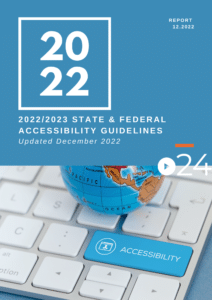Brand digital accessibility is an ongoing issue that the pandemic has clearly highlighted. Though 15%…

Digital Accessibility Trends
Digital accessibility has evolved and innovated a great deal over the years. However, as we enter 2023, digital accessibility is a major issue for many organizations around the country and the world. Keeping up with digital accessibility trends is important for organizations to stay in compliance as well as provide the very best assistance to those with disabilities.
With only 3% of the internet being accessible to those with disabilities, the rise of digital accessibility lawsuits has become a looming issue for almost every organization with online content and/or platforms.

Having said that, the future of digital accessibility includes efforts to make these technologies and strategies more readily available and cost-effective for organizations to implement them. Here are the top digital accessibility trends that can take hold in 2023.
A Technology-First Approach
Contracting an external specialist in digital accessibility has proven to be costly and ineffective at scale. However, utilizing technology and human intelligence can combine the efficiency of technology with human judgment to create an effective solution. Thus, adopting a technology-first approach allows automation to monitor and fix the majority of accessibility errors. This is then followed by human curation to solve the remaining complex issues.
Clear Legal Framework and Guidance
Title III of the ADA is a subjective provision that leaves much up to interpretation when approaching digital accessibility issues. However, earlier in 2022, the Department of Justice issued guidance on web accessibility that reminded organizations to make accessible websites. In 2023 and beyond, the Websites and Software Applications Accessibility Act is a proposed bill that would clarify Title III of the ADA and apply to it digital-only businesses.
Crucial Assistive Technologies for Digital Accessibility Trends
Around 15% of the world’s population lives with a disability. Chances are, your organization has customers, audiences, or clients that may also require these crucial assistive technologies.
Speech Recognition
Speech recognition software is ingrained in our society nowadays with the popularity of Alexa and Siri. However, for students with disabilities, speech recognition can solve many significant issues. Those with visual disabilities, motor and cognitive impairments, and learning restrictions can benefit greatly from the availability of speech recognition software.
Refreshable Braille Readers
The ADA mandates that auxiliary services and aids are necessary for communication. For organizations to satisfy this requirement, refreshable Braille readers are ideal for audiences with visual impairments. These readers can convert all text on a screen into an 80-cell Braille display. Thus, websites can be made accessible to this specific segment of any organization’s audience.
Assisted Reading Applications
Assisted reading applications are ideal for those with low vision or dyslexia. These applications read material aloud while highlighting text. What’s more, users can customize settings including the color of text, background and highlight color, margins, text size and font, as well as letter and line spacing. Not only does this assist in reading comprehension, but it also allows those with disabilities easier access to web content.
cielo24 provides robust Video solutions for Digital Accessibility
 Looking for Audio Description? Get started with a WCAG-compliant Audio Description product.
Looking for Audio Description? Get started with a WCAG-compliant Audio Description product.
cielo24’s new Audio Description solution improves the video experience for people with low vision, vision impairment, and blindness. Give it a try now >>



